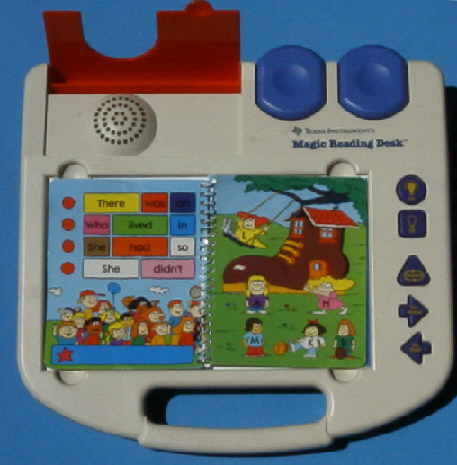
DATAMATH CALCULATOR MUSEUM
 |
DATAMATH CALCULATOR MUSEUM |
Texas Instruments Magic Reading Desk
| Date of introduction: | 1992 | Display technology: | n.a. |
| New price: | $38.25 (1992) Libraries: $19.95 |
Display size: | |
| Size: | 10.6" x 11.5" x 2.6" | ||
| Weight: | 1 pound 13 ounces | Serial No: | |
| Batteries: | 4*AA-cells | Date of manufacture: | mth 01 year 1993 |
| AC-Adapter: | Origin of manufacture: | China | |
| Precision: | Integrated circuits: | TSP50C42, TSP60C80 | |
| Memories: | |||
| Program steps: | Courtesy of: | Joerg Woerner |
 Texas
Instruments continued with the Magic Reading Desk the spirit of the Super Speak & Read.
The toy is a combination of the previous
Speak & Read and the position sensitive keyboard of the
Touch &
Tell game.
The integrated voice synthesizer will ask you different questions and you have
to show with your fingertip the answers.
Texas
Instruments continued with the Magic Reading Desk the spirit of the Super Speak & Read.
The toy is a combination of the previous
Speak & Read and the position sensitive keyboard of the
Touch &
Tell game.
The integrated voice synthesizer will ask you different questions and you have
to show with your fingertip the answers.
Dismantling
a Magic Reading Desk manufactured in May 1990 China reveals a very efficient internal construction centered around a TSP50C4X
Speech Synthesizer and supported with a TSP60C80 Speech-ROM.
We located on the double-sided printed circuit
board (PCB) two Integrated Circuits:
|
• TSP50C42/CSM42008: TSP50C50 VSP (Voice Synthesis Processor) with 8-bit microcontroller and 8k Bytes Mask ROM for both program and voice and
128 Bytes + 16 Nibbles RAM • TSP60C80/CMM80002: VSM (Voice Synthesis Memory) with 1024k Bits |
The Magic Reading Desk uses exchangeable Speech-ROMs in an expansion port. Each of them corresponds to a set of different booklets.
18 different booklets are known already from the Super Speak & Read and its clone Ready...Set...Read!
|
• Blue: Basic set (1..4) • Orange: Reading Fun 1 Expansion Pack (5..11) • Purple: Reading Fun 2 Expansion Pack (12..18) |
If you have additions to the above article please email: joerg@datamath.org.
© Joerg Woerner, December 5, 2001. No reprints without written permission.